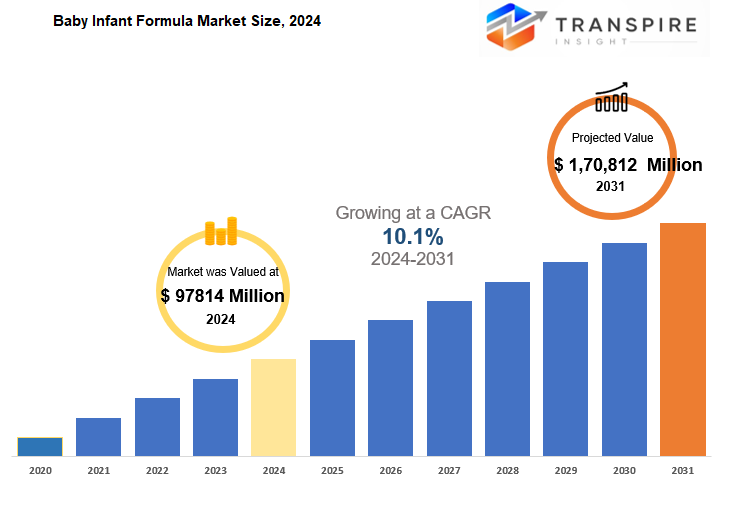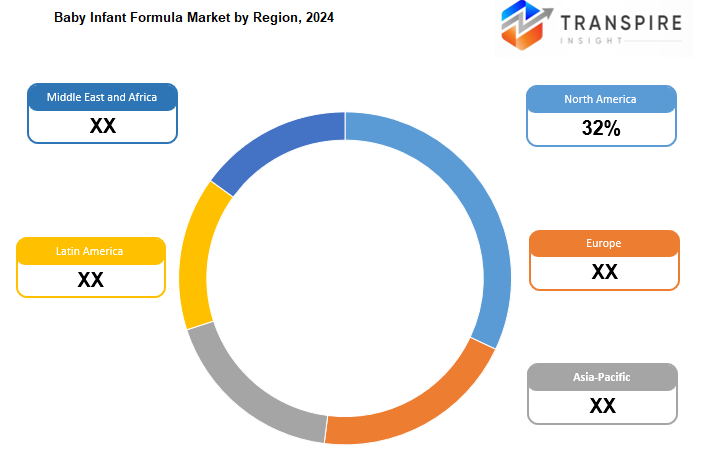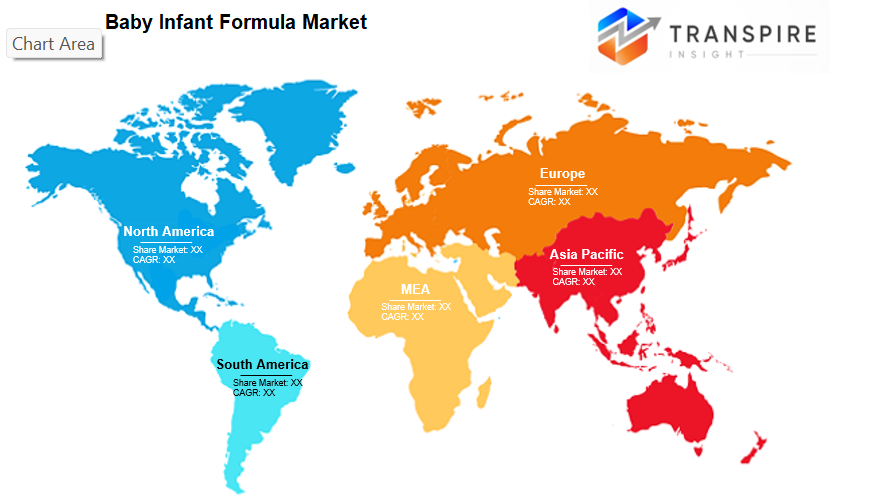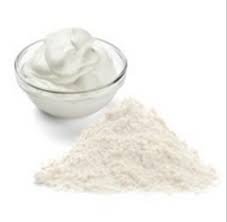Global Baby Infant Formula market is estimated to reach $1,70,812 Million by 2031; growing at a CAGR of 10.1% from 2024 to 2031.
The Global Baby Infant Formula market is set to become a significant sector in the food and nutrition industry, driven by parents' need for reliable and healthy baby food products. The market will cater to various dietary needs, preferences, and allergies of infants, including organic and plant-based formulas for health-conscious consumers. Specialized formulas for premature and low-birth-weight infants will also be developed.
Companies are expected to invest in research and development to enhance product formulations with essential nutrients like vitamins, minerals, and fatty acids, along with probiotics and prebiotics for gut health. Global distribution of baby infant formula will increase access and affordability in emerging markets, while companies will work with local distributors to ensure products reach underserved regions. Regulatory frameworks around product safety, labeling, and nutrition will influence the market, leading to increased transparency in brand-consumer interactions. Companies will need to adopt green practices and innovative packaging to cater to consumers' values of sustainability and ethical sourcing.
Overall, the market will focus on meeting the changing needs of parents and infants, ensuring child health and well-being are prioritized in the years ahead.

GROWTH FACTORS
The global market for baby infant formula is expected to grow significantly due to the importance of infant nutrition and health. Parents are realizing the significance of early childhood nutrition and are seeking convenient and balanced nutrition options for their infants. Factors such as busy lifestyles and mothers returning to work soon after childbirth are driving the demand for formula that closely mimics the nutritional value of breast milk. However, high prices of premium formula brands and safety concerns regarding the quality of infant formula products pose challenges for market growth.
Despite these challenges, the market presents opportunities for growth and innovation. There is a growing demand for organic and clean-label products, with consumers favoring natural products free from artificial additives. Companies can capitalize on this trend by offering organic baby formula to health-conscious parents. Research and technological advancements also offer opportunities for improving the nutritional aspects of infant formula, making it more appealing to parents worldwide.
While challenges exist, such as high costs and safety concerns, the baby infant formula market is poised for growth. Addressing these challenges and seizing opportunities for innovation can help shape the future of infant nutrition and well-being for future generations. Increasing awareness about infant health and nutrition, coupled with the demand for convenient feeding options, indicates a promising outlook for the global baby infant formula market.

MARKET SEGMENTATION
By Type
The Global Baby Infant Formula market is expected to grow due to increased awareness about infant nutrition and more working parents. The market is segmented into four categories: Infant Milk for newborns, Follow-On Milk for older babies, Specialty Baby Milk for infants with health issues, and Growing-Up Milk for toddlers.
Infant Milk is essential for babies who can't be breastfed, Follow-On Milk complements solid foods for older babies, Specialty Baby Milk caters to babies with health needs, and Growing-Up Milk is for toddlers transitioning to solid foods. As parents become more health-conscious, the demand for Specialty Baby Milk and Growing-Up Milk is expected to rise.
The market will continue to evolve to meet the needs of infants and toddlers, with each segment offering specific benefits for children's growth and development. The future of feeding infants will be shaped by the preferences of parents and the market's ability to innovate and adapt to changing consumer demands.
By Ingredient
The Global Baby Infant Formula market is evolving as parents seek nutritious options for their infants. The market is driven by the increasing awareness of the importance of nutrition in a baby's early years. The market can be segmented based on ingredients like carbohydrates, fats, and proteins to meet the nutritional needs of infants. For example, carbohydrates provide energy, fats support brain development, and proteins aid in muscle development and immune system strengthening. Vitamins and minerals like iron, calcium, and DHA are also essential for cognitive and physical development.
Manufacturers are constantly innovating to include new ingredients like probiotics and prebiotics to enhance gut health and explore the gut-brain axis. The market will continue to adapt to new consumer preferences and advancements in food science technologies, ensuring products meet the important needs of infants while prioritizing safety and quality. The future of the market will focus on providing the best nutritional support to infants to set them on a healthy path for the future. Ultimately, the goal is to offer products that nourish infants and make them feel well, resulting in a more dynamic and responsive market that caters to the needs of modern families.
By Product Form
The global baby infant formula market is expected to continue growing due to factors such as increased birth rates and awareness of infant nutrition. The market plays a vital role in providing infants with essential nutrients during their early years. Powdered formula is preferred by parents for its convenience and longer shelf life, allowing for easy preparation and storage.
Demand for organic and natural ingredients is on the rise, leading to new formulations. Liquid formulas, including concentrated and ready-to-drink options, are also gaining popularity among parents looking for convenience. Ready-to-feed formulas, which require no preparation, are becoming more sought after by new parents seeking hassle-free feeding.
Companies in the market will need to focus on product formulation, packaging, and marketing strategy innovations to cater to changing consumer preferences. As awareness about proper infant nutrition increases, the market will continue to evolve to meet the diverse needs and preferences of families worldwide.
REGIONAL ANALYSIS
The global baby infant formula market is changing due to regional dynamics, with North America, Europe, Asia-Pacific, South America, and Middle East & Africa being key regions. In North America, the demand for specialized, organic, and non-GMO formulas is growing. Europe is focused on high-quality products with transparent labeling and strict regulations.
In Asia-Pacific, the rising middle class is driving demand for premium baby formula. South America, particularly Brazil and Argentina, is experiencing growth despite economic instability. The Middle East & Africa are also seeing increased demand due to urbanization and changing consumer behavior.
Each region has its own cultural, economic, and regulatory factors affecting the market. Companies that are responsive to local needs and innovation are likely to succeed in this competitive market.

KEY INDUSTRY PLAYERS
The global baby infant formula market is expanding rapidly due to parental concerns about infant nutrition. Key players like Abbott Laboratories and Nestle S. A. lead the industry with a focus on research and development, ensuring quality and safety in their products. Companies like Arla Foods and Danone prioritize natural ingredients and sustainability to meet consumer demands for transparency and health consciousness.
Beingmate Group Co. Ltd. and HiPP GmbH & Co. Vertrieb KG target regional markets with localized products based on taste and preference. Mead Johnson & Company LLC and The Hain Celestial Group focus on innovative packaging to cater to busy parents, offering convenience with single-serve packages and ready-to-use formulas.
Traditional food companies like Campbell Soup Company and Kraft Heinz are entering the market, intensifying competition and prompting established players to enhance their product lines. FrieslandCampina and Perrigo may focus on strategic partnerships and acquisitions to stay competitive, while engaging with healthcare professionals and influencers to build trust with consumers.
Overall, these major players in the global baby infant formula market are adapting to changing consumer preferences and challenges, creating opportunities for growth and innovation. Through a commitment to quality and nutrition, these companies will continue to shape the industry and meet the evolving needs of parents and infants.
REPORT SCOPE AND SEGMENTATION
|
Attributes |
Details |
|
Market Size By 2031 |
USD 170812 Million |
|
Growth Rate |
CAGR of 10.1% |
|
Forecast period |
2024 - 2031 |
|
Report Pages |
250+ |
|
By Type |
|
|
By Ingredient |
|
|
By Product Form |
|
|
By Distribution Channels |
|
|
By Region |
|
|
Key Market Players |
|



_page-000110.jpg)
_page-000122.jpg)
_page-000121.jpg)
_page-000120.jpg)
_page-000119.jpg)

5.jpg)

4.jpg)


 APAC:+91 7666513636
APAC:+91 7666513636





